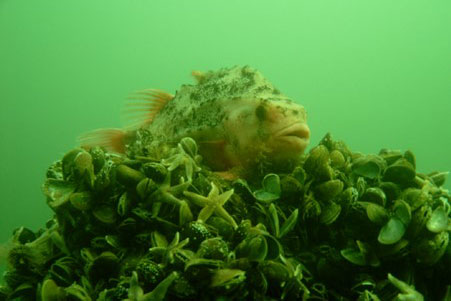
This reef project is currently the only one of its kind in the Baltic Sea to have provided data over such a long time period.
Fish populations in the Baltic Sea have been fluctuating and, in the worst cases decreasing since the 1990s. One of the reasons is habitat degradation. The German Mecklenburg-Vorpommern Research Centre for Agriculture and Fisheries launched a study to look into the technical feasibility of developing artificial reefs and whether they could be beneficial to local fisheries. Today, two artificial reefs have been built and the results are promising.
Both reefs consist of natural rocks and various underwater structures made of concrete reef cones, tetrapods and concrete rings. Additionally, mesh fabrics and lines act as substrates on which seaweed, mussels and other benthic organisms can grow. They provide large-scale artificial underwater habitats that create zones for recruitment, growth and rest for the fish species present in the area. Ongoing scientific investigations have proved that the fishing value of the sea areas around the reefs has increased. The reefs provide shelter and feeding grounds for many species. To achieve a measurable benefit for local fisheries, however, more reefs would have to be established in suitable areas along the coast.
The Fraunhofer Institute for Graphical Data Processing in Rostock will take over maintenance and further investigations of the reef areas and are looking into adding more reef areas to further investigate their influence on the marine environment as well as aquaculture options in and around reef structures.
- Project locations
- Germany
- Overall budget
- €1 264 998
- EU contribution
- €948 74875% of the overall budget
- Project website
- REEF NIENHAGEN :: (riff-nienhagen.de)
Results
The structures in the water column give the reefs a very high biodiversity in comparison to the sandy or marly substrates that surround them. They are especially advantageous for young cod, which have a better chance of survival and – according to observations from tagging experiments – return to the same spots when they are older.
The latest observations from August 2022 showed that one-year-old cod are loyal to the reef areas and are two to three times as numerous there compared to reference areas.
Over the years, young fish have spread across a large area around each reef. Overall, the reefs are interesting to many species and the researchers have found more than 30 different species, some of which are rare.
Contact
- Organisation
- Landesforschungsanstalt für Landwirtschaft und Fischerei
- info
 riff-nienhagen [dot] de
riff-nienhagen [dot] de - Phone number
- +49 (0) 151-46378309
- Postal address
- Germany
